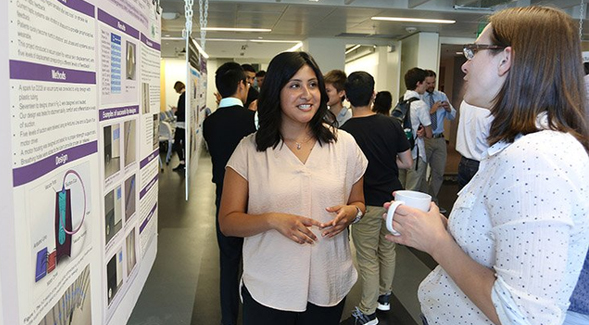From Maintaining Machines to Restoring Limb Function
SDSU engineering student and Navy veteran Laura Sandoval is helping people with spinal cord injuries to regain the use of their arms and legs.

Laura Sandoval enlisted in the U.S. Navy to find discipline. Now as an engineering student conducting research at San Diego State University's Center for Sensorimotor Neural Engineering (CSNE), she’s working across disciplines, fusing cutting-edge neuroscience and biomechanical engineering to help restore limb function to people with spinal cord injuries.“Laura came to our lab about two years ago as a very focused and highly motivated young student looking for an opportunity to interact with grad students and learn new things.”
Sandoval grew up in Huntington Park in Los Angeles County. The daughter of a machinist, she was always comfortable around tools and motors but never dreamed she’d work on machines that launched jets from the deck of an aircraft carrier or build tiny devices that read brain signals directly from firing neurons.
After attending community college in Los Angeles, she wanted a university education. She didn’t have the money to pay for it, though, so she turned to the military. Sandoval enlisted in the Navy and was assigned to work as a machinist’s mate aboard the USS John C. Stennis aircraft carrier. In her position she operated, maintained and repaired various types of ship machinery.
“I thought, no way, that’s a boy job,” she recalled, “but I loved how hands-on it was, and how it engaged my critical thinking skills. It taught me to be really diligent in my work and to trust others.”
In her 2.5 years in the military, she also got to travel the world. In addition to Coronado Island, she visited Chicago, Bahrain, Kuwait, Malaysia, Dubai and Germany. But it was San Diego she fell in love with and San Diego State University she chose to attend.
When she got out of the Navy, Sandoval used her G.I. Bill funds to attend SDSU and looked for a way to transition her knack for machines into engineering research. She also knew many fellow servicemen and servicewomen who suffered limb and spinal cord injuries during combat, and was inspired by their success in living and thriving with prosthetics.
When Sandoval heard about CSNE, she knew it was a perfect fit. Led by mechanical engineering professor Sam Kassegne, SDSU’s CSNE lab is part of a collaboration with the University of Washington and the Massachusetts Institute of Technology that explores how tiny devices implanted in the brain can power prosthetic limbs or reroute brain signals around damaged nerves to restore motor function.
“Laura came to our lab about two years ago as a very focused and highly motivated young student looking for an opportunity to interact with grad students and learn new things,” Kassegne recalled.
Sandoval works with her mentor, graduate student Mieko Hirabayashi, to fabricate microchips with tiny electrode wires that read the brain’s electrical signals and transmit those signals to receivers. Ordinarily, these signals would travel through the body’s nerves to limb muscles, but spinal cord injuries essentially create a roadblock that prevents brain signals from reaching muscles. By transmitting the brain signals to a receiver in the limbs, the signals are translated back into electrical impulses, stimulating the muscles and restoring some degree of movement and function.
Sandoval credits the SDSU Mathematics, Engineering, Science Achievement (MESA) program with helping her navigate the complexities of enrolling in classes, planning out her major and getting involved in research. To give back, she volunteers in community projects with MESA, demonstrating the value of a science, technology, math or engineering education.
Last summer, Sandoval participated in the CSNE Research Experience for Veterans program, which sent her to the University of Washington for 10 weeks to conduct research, attend lectures and seminars and present her team’s findings. She plans to graduate from SDSU in 2019 and then attend graduate school, possibly focusing on prosthetics engineering.
“Based on Laura’s excellent contributions, she earned a spot as a co-author in one of our papers," said Kassegne. “Laura is a very promising engineer, and I can see her going far.”
Sandoval encourages everyone who might be interested in engineering research to pursue it, regardless of their circumstances. At SDSU, the Troops to Engineers program offers internships, networking opportunities and professional development to help veterans find their way into fulfilling engineering careers.
“Growing up, I wanted to go to college, but when I graduated from high school, I didn’t know if it was feasible,” Sandoval said. “I want young people to know there are ways. Reach out to people, figure out how to transfer from a community college, how to translate your experiences. Don’t be afraid to ask questions.”



